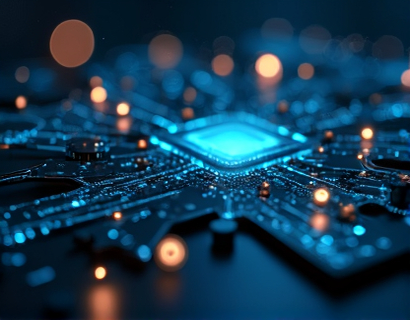AI-Driven Personalized Learning: Transforming Education Through Adaptive Technology
In the rapidly evolving landscape of education, the integration of artificial intelligence (AI) has emerged as a transformative force, redefining how we approach learning. AI-driven personalized learning platforms are revolutionizing the educational experience by offering tailored, adaptive education that caters to the unique needs and learning styles of each individual. This shift towards personalized learning is not just a trend but a necessary evolution to ensure that education remains accessible, effective, and engaging for all students, from K-12 to lifelong learners.
The Need for Personalized Learning
Traditional educational models often struggle to meet the diverse needs of students, leading to a one-size-fits-all approach that can leave many learners behind. Recognizing and addressing individual differences in learning pace, style, and interests is crucial for fostering an inclusive and effective learning environment. AI-driven personalized learning platforms bridge this gap by leveraging advanced algorithms and machine learning techniques to create customized learning paths for each user. These platforms analyze vast amounts of data to understand a student's strengths, weaknesses, and preferences, allowing for real-time adjustments to the learning material and pace.
How AI Personalizes the Learning Experience
At the core of AI-driven personalized learning is the ability to adapt to the unique characteristics of each learner. Here’s how this technology works to enhance the educational experience:
- Data Collection and Analysis: AI systems continuously collect data on student interactions, performance, and feedback. This data is analyzed to identify patterns and insights that inform the customization of learning content.
- Adaptive Content Delivery: Based on the analysis, the platform adjusts the difficulty level, type of content, and presentation style to match the learner's needs. For instance, a student who grasps concepts quickly might be presented with more challenging material, while another who needs more time might receive additional explanations and practice exercises.
- Real-Time Feedback: AI provides instant feedback on assignments and quizzes, helping students understand their mistakes and learn from them immediately. This immediate reinforcement is crucial for reinforcing correct concepts and correcting misunderstandings.
- Personalized Learning Paths: The platform creates a customized learning journey for each student, ensuring that they progress through the material in a way that aligns with their individual goals and capabilities.
Benefits of AI-Driven Personalized Learning
The benefits of AI-driven personalized learning are manifold, impacting students, educators, and the broader educational system in profound ways:
Enhanced Learning Outcomes
By tailoring the learning experience to individual needs, AI-driven platforms significantly improve academic performance. Students are more likely to engage with material that is appropriately challenging and relevant to their interests, leading to better retention and understanding of concepts.
Increased Engagement and Motivation
Personalized learning environments are more engaging and motivating for students. When learners see that the system understands and supports their unique learning journey, they are more likely to be invested in their education. This increased engagement translates into higher participation rates and a more positive attitude towards learning.
Support for Diverse Learning Styles
Every student has a unique learning style, whether they are visual, auditory, kinesthetic, or a combination. AI-driven platforms can cater to these diverse preferences by offering a variety of content formats, such as videos, interactive simulations, and text-based explanations. This flexibility ensures that all students can access and process information in the way that works best for them.
Empowerment of Lifelong Learners
AI-driven personalized learning is not limited to traditional students; it also benefits lifelong learners seeking to acquire new skills or deepen their knowledge in specific areas. These platforms provide flexible, self-paced learning opportunities that fit into busy schedules, making continuous learning more accessible and manageable.
Reduced Teacher Workload
By automating routine tasks such as grading and providing instant feedback, AI-driven platforms alleviate some of the administrative burdens on educators. This allows teachers to focus more on personalized instruction, mentorship, and creating enriching classroom experiences.
Implementing AI in Education: Challenges and Considerations
While the potential of AI-driven personalized learning is vast, its implementation comes with several challenges that must be addressed to ensure successful integration:
Data Privacy and Security
Protecting student data is paramount. Educational institutions must implement robust data security measures to safeguard sensitive information and comply with regulations such as the General Data Protection Regulation (GDPR) and the Family Educational Rights and Privacy Act (FERPA). Transparency about data usage and obtaining informed consent from students and parents are essential steps.
Equity and Accessibility
Ensuring that AI-driven personalized learning is accessible to all students, regardless of socioeconomic background or geographic location, is crucial. This involves addressing the digital divide by providing necessary infrastructure and support to underserved communities. Additionally, the technology should be designed to be inclusive, accommodating students with disabilities and those who speak different languages.
Teacher Training and Support
Educators play a vital role in the successful implementation of AI-driven personalized learning. Providing comprehensive training and ongoing support is essential to help teachers understand and effectively use these tools. This includes training on how to interpret data insights, integrate AI recommendations into their teaching practices, and maintain a human-centered approach to education.
Continuous Improvement and Adaptation
AI systems must be continuously updated and improved based on feedback and new data. This requires a commitment to ongoing research and development to ensure that the platforms remain effective and relevant. Collaboration between educators, technologists, and researchers is key to driving innovation and addressing emerging challenges.
Case Studies and Success Stories
Several educational institutions and platforms have successfully implemented AI-driven personalized learning, demonstrating its positive impact:
K-12 Education
In a pilot program, a group of middle schools integrated an AI-driven personalized learning platform into their curriculum. The results were striking: students showed a 20% increase in math proficiency and a 15% improvement in reading skills over the course of a year. Teachers reported higher student engagement and a more positive classroom atmosphere.
Higher Education
A university implemented an AI-powered adaptive learning system for its online courses. The platform adjusted the difficulty of course materials based on student performance, leading to a 25% reduction in dropout rates and a 10% increase in course completion rates. Students appreciated the tailored support and the ability to learn at their own pace.
Lifelong Learning
An online learning platform for professionals used AI to offer personalized career development paths. Users reported significant advancements in their skills and career progression, with many attaining promotions or switching careers within a year of using the platform. The flexibility and accessibility of the platform made continuous learning a feasible and attractive option for busy professionals.
Future Trends in AI-Driven Personalized Learning
The future of AI-driven personalized learning is promising, with several trends shaping its evolution:
Integration of Augmented and Virtual Reality
Combining AI with augmented reality (AR) and virtual reality (VR) can create immersive learning experiences that further enhance engagement and understanding. For example, VR can simulate real-world scenarios for practical training in fields like medicine and engineering, while AR can overlay interactive content onto the physical environment, making learning more interactive and memorable.
Emotional Intelligence and Well-Being
Future AI systems may incorporate emotional intelligence to monitor and support students' emotional well-being. By detecting signs of frustration or disengagement, these systems can offer personalized interventions, such as mindfulness exercises or breaks, to help students maintain a positive learning attitude.
Collaborative Learning Environments
AI can facilitate collaborative learning by connecting students with similar interests and learning goals, fostering peer-to-peer learning and community building. Virtual study groups and collaborative projects can be optimized using AI to ensure that all participants are engaged and contributing effectively.
Conclusion
AI-driven personalized learning represents a significant leap forward in education, offering a tailored, adaptive, and supportive learning environment that empowers students of all ages to reach their full potential. By addressing the unique needs and learning styles of each individual, these platforms not only enhance academic outcomes but also foster a love for learning that extends beyond the classroom. As the technology continues to evolve, the potential for transformative educational experiences is limitless, paving the way for a more inclusive and effective education system for all.










































